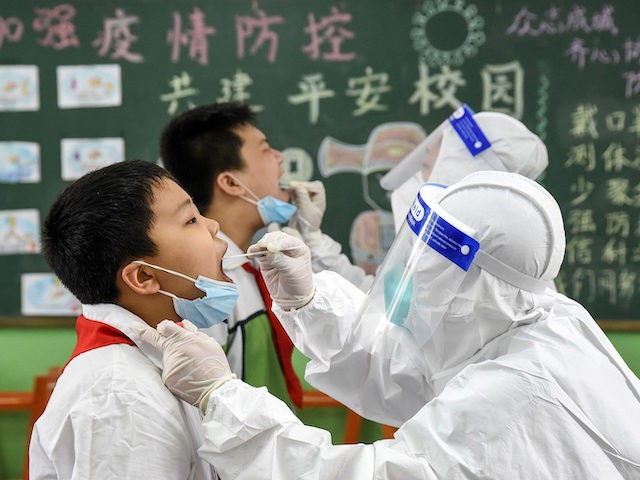Chinese public health officials identified two outbreaks of Chinese coronavirus in the eastern provinces of Liaoning and Anhui — about 900 miles away from each other — on Sunday, once again calling into question Beijing’s claims that it has subdued the pandemic.
The Chinese Communist Party used a visit by dictator Xi Jinping to Wuhan, the central city where the virus originated, in March 2020 to declare it had defeated the national coronavirus epidemic. Since then, countless outbreaks have occurred in nearly every province in the country, some preceded by mass gatherings meant to showcase China’s success in epidemic control, such as the New Year festivities in Wuhan this January.
More recently, Chinese public health experts — most notably top infectious disease expert Zhong Nanshan — have warned China may soon face a resurgence of the virus due to paltry public interest in receiving doses of China’s homemade coronavirus vaccine candidates. Zhong in particular has warned China’s vaccination rate is so slow that much of the world may reach herd immunity before China does, despite it being the country with the most exposure to the disease.
China’s Global Times reported Sunday that medical experts in both cities had identified 29 coronavirus cases total. While the initial number is low — and it includes asymptomatic cases, which China does not include in its official tally — Chinese authorities expressed concern that the group had traveled throughout the country, including six different provinces where they may have exposed others to the virus. The state propaganda outlet claimed the earliest identified cases came from Liaoning, one of China’s most northern provinces on the border with North Korea.
Nationwide, China documented 25 official cases of coronavirus Sunday, though it expressed the most interest in those from the two eastern provinces because officials identified these as cases of local transmission.
“As an inland province, the possibility that Anhui’s resurgence resulted from imported cases is low. But Liaoning, the province where Yingkou is located, had reported several domestic outbreaks triggered by imported cases,” an alleged Chinese public health expert told reporters at a press conference, according to the Global Times. The state newspaper emphasized that Yingkou is the destination for many global imports, including frozen food. Chinese authorities have for months, without evidence, made the claim that the virus could have originated abroad but entered China through cold-chain shipping, a theory that has no significant backing in the currently available library of scientific studies on food and coronavirus.
While identifying Liaoning as the likely origin location of the latest outbreak, the Global Times‘ stable of government-approved experts did not raise the possibility of illegal trade between China and North Korea, through the Liaoning border, playing a role in spreading coronavirus. The communist government of North Korea has officially documented zero cases of Chinese coronavirus since the pandemic began, alleging its pandemic response of definitively shutting its borders has resulted in a perfect record. Few international experts believe this to be the true case, however, as the Kim Jong-un regime has repeatedly indicated it is enduring a significant crisis. The dictator himself referred to the current state of North Korea as its “worst-ever situation” in a recent speech.
On the pages of the Global Times, the Chinese government attempted to portray the latest outbreak as a positive development, in that it may help spur demand for coronavirus vaccine doses. The state propaganda outlet noted Liaoning and Anhui have two of the lowest rates of vaccination nationwide — 8.4 and 7.3 percent of the population in each, respectively, is fully vaccinated — and claimed reports of a new outbreak created “long queues of people lining up” to receive doses of Chinese-made vaccines in both regions. The Chinese Communist Party has documented the administration of 390 million doses of coronavirus vaccine candidates nationwide; most approved products in the country require two doses, so the total vaccinated population is about half of that number. China’s population is about 1.4 billion people, meaning only about 23 percent of the country is vaccinated, according to Zhong, the infectious disease expert.
In comparison, nearly half of eligible Americans have received at least one dose of a coronavirus vaccine. The total number of Americans fully vaccinated is at 37 percent as of Monday, according to the U.S. Centers for Disease Control (CDC).
“Although China currently leads the world in terms of the number of COVID-19 [Chinese coronavirus] vaccinations administered, the coverage rate in the country is only about 23%, lagging behind other countries such as Israel, the US and the UK,” Zhong noted last week. Zhong had previously warned that other nations could possibly reach herd immunity before China due to the nation’s hesitancy to receive vaccine doses. The Global Times expressed hope that the current outbreak would change the tide Sunday.
“Chinese vaccine experts said the resurgence, coming four months after the outbreaks in winter, is somewhat healthy for China, as having this kind of stress test can increase the country’s vaccination momentum,” the Global Times claimed.

COMMENTS
Please let us know if you're having issues with commenting.